FINN~ISH photos
Wednesday, November 23rd, 2005
Latest posts:
November 23: FINN~ISH photos
November 20: Ultrasound 2005 warm-up photos + FINN~ISH in Hackney
November 11: Ultrasound 2005
October 25: Casey Reas + Marius Watz lecture summary
October 16: Piksel05 - artistic program online
September 28: DOORS NIGHT HELSINKI!
September 26: PixelACHE // Mal au Pixel - Call for Projects update
September 21: ColomboPixel part one: Salón Internacional del Autor Audiovisual in Barranquilla, Colombia
September 14: Casey Reas & Marius Watz lectures in Helsinki
July 22: PixelACHE // Mal au Pixel 2006 & PixelACHE 2005 web updates!
Blog archives »
Sunday, November 20th, 2005
A couple of photos from the MEMNON performance at Ultrasound 2005 warm-up
event in a Huddersfield, UK.
There is another Ultrasound 2005 warm-up event coming up in London
next Monday (21 Nov), organised together with the Ambienttv.net crew…
Come and see the FINN~ISH!
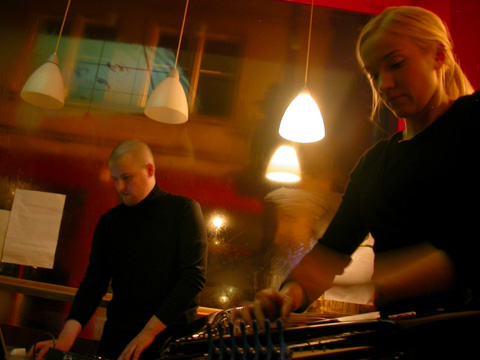
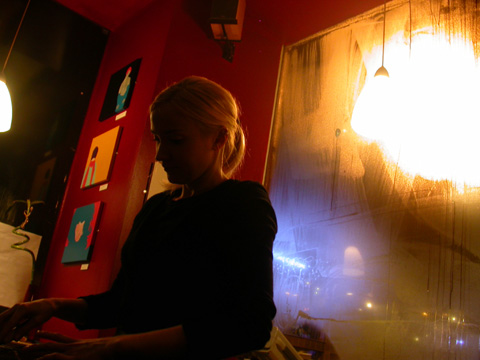
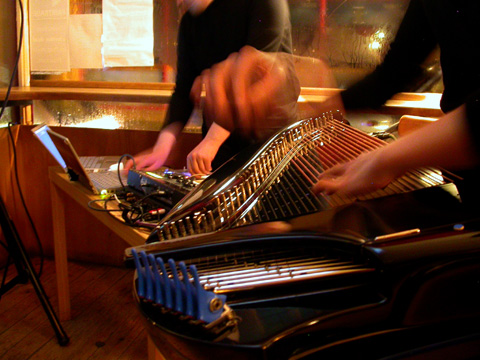
Friday, November 11th, 2005
Mon 21 - Sat 26 Nov 2005
The Media Centre and Bates Mill
Huddersfield
England
Ultrasound 2005 presents a diverse programme of live performances, installations, workshop and talks by UK and international artists working in new interdisciplinary ways across the interrelated fields of new media, contemporary electronic music, software production, new technologies and audiovisual performance.
We are pleased to announce the ‘Finnish Partition’ of the festival, programmed in collaboration with Helsinki based artist, organiser and curator Juha Huuskonen. The ‘Finnish Partition’ represents a cross-section of the new and emerging creative talent practising media arts in Finland today, supported by established names such as Pan Sonic.
The festival takes place at The Media Centre and Bates Mill, two contrasting venues. The Media Centre is home to over 60 creative industries enterprises, while Bates Mill is a traditional Mill complex just outside Huddersfield town centre. The performances at Bates Mill are located in the old ‘Blending Shed’ a 5,000 sq ft industrial space.
Ultrasound Outline Programme:
Live Performances
Pan Sonic [Finland]
http://www.ultrasound.ws/pan-sonic.html
Grey Zone [Finland]
http://www.ultrasound.ws/greyzone.html
Memnon [Finland]
http://www.ultrasound.ws/memnon.html
Sue Costabile [USA]
http://www.ultrasound.ws/costabile.html
AGF [Germany]
http://www.ultrasound.ws/agf.html
Aymeric Mansoux [France]
http://www.ultrasound.ws/mansoux.html
O Samuli A [Finland]
http://www.ultrasound.ws/oa.html
Marloes de Valk [Holland]
http://www.ultrasound.ws/de-valk.html
Owl Project [UK]
http://www.ultrasound.ws/owl-project.html
Jaap Blonk [Holland]
http://www.ultrasound.ws/blonk.html
Golan Levin [USA]
http://www.ultrasound.ws/levin.html
Zachary Lieberman [USA]
http://www.ultrasound.ws/lieberman.html
The World of PIKU [Finland]
http://www.ultrasound.ws/piku.html
Pardon Kimura [Japan]
http://www.ultrasound.ws/kimura.html
The Sancho Plan [UK]
http://www.ultrasound.ws/sancho-plan.html
Installations
Scrollbars
by Jan Robert Leegte and Edo Paulus [Holland]
http://www.ultrasound.ws/scrollbars.html
Kick Ass Kung-Fu
by Perttu Hämäläinen, Mikko Lindholm, Ari Nykänen [Finland]
http://www.ultrasound.ws/kung-fu.html
Workshop
Tiletoy
A Modular Electronic Game Prototype
by Tuomo Tammenpää & Daniel Blackburn [Finland / UK]
Open software / open hardware
TileToy is an open project. Both the source code and the hardware will be made available via open licenses. The aim of TileToy is not just to create something that we ourselves can use to create interesting games and demos for, but as a platform that anyone can use to create unique content. Making the software open will allow people to create their own applications and games and feed these back into the community to spark further innovation. The open hardware will also allow people to make their own TileToys cheaply without paying a third party potentially leading to new projects that branch off to make new versions of TileToy based on the original hardware.
http://www.ultrasound.ws/tiletoy.html
Further additions to the programme will be announced soon. Please visit the website or sign up to the electronic mailing list.
Tuesday, October 25th, 2005
A short summary of the lectures Casey Reas and Marius Watz at Lume Media Centre, an event which was organised by PixelACHE & friends (see earlier posting)
* * *
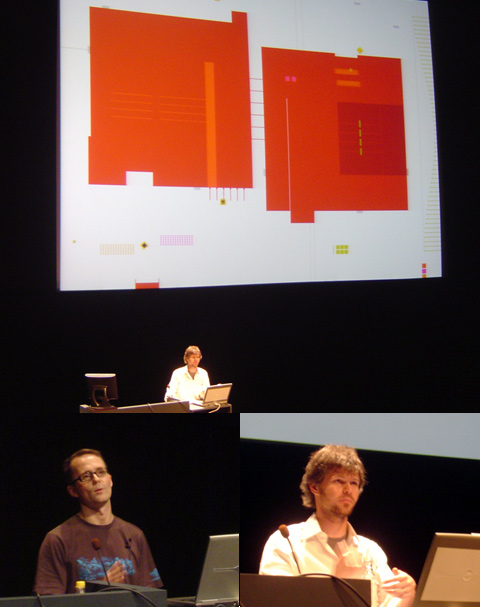
Marius Watz (on the left) and Casey Reas
Photos: Jokko Korhonen
Text: Juha Huuskonen
Casey and Marius arrived to Helsinki straight from the Generator.x conference / exhibition in Oslo, an ambitious project initiated by Marius Watz. Generator.x brought together an international group of artists / designers / researchers to explore ‘the current role of software and generative strategies in art and design’.
Marius quoted the definition of generative art from Philip Galanter:
Generative art refers to any art practice where the artist uses a system, such as a set of natural language rules, a computer program, a machine, or other procedural invention, which is set into motion with some degree of autonomy contributing to or resulting in a completed work of art.
(here is the academic paper where the quote is from)
Another relevant quote from Generator.x:
True literacy means being able to both read and write. If to use pre-existing software is to “read” digital media, then programming is the equivalent to writing. The Generator.x project focuses on artists and designers who embrace this new literacy not as a technical obstacle, but as a way to redefine the tools and the media they work in.
This is a slightly modified version of an original statement from Alan Kay:
The ability to ‘read’ a medium means you can access materials and tools created by others. The ability to ‘write’ in a medium means you can generate materials and tools for others. You must have both to be literate. In print writing, the tools you generate are rhetorical; they demonstrate and convince. In computer writing, the tools you generate are processes; they simulate and decide.
* * *
The presentations by Casey and Marius were chronological, they both started by telling how they first got involved in software design / generative art and continued to elaborate on how their own practise and they whole field had evolved during the past few years.
Casey mentioned book ‘Vehicles, Experiments in Synthetic Psychology’ by Valentino Braitenberg as an influential source for his earlier projects such as tissue software. There is an article by Casey about this in the Ars Electronica 2003 catalogue.
* * *
Both Casey and Marius mentioned several reasons why software programming and other generative methods can be interesting for contemporary design and art:
* Designers (and artists) often accept to work with certain materials which are available to them. In the case of software it’s possible to create ‘new materials’ and reach new kind of results. (Marius)
* The focus in design changes from composition and color to other qualities such as mass and texture (Casey) or movement and intelligence (Marius). Marius presented one example of his work where he had tried to let go of deciding the colors and instead allowing the generative algorithms make the decisions.
* The work is continous, it has no beginning or end (Casey).
* Work is non-material and in it’s essence can be described as a set of instructions (Casey).
* * *
Casey told that some sources of inspiration for his recent work are artists like Sol LeWitt, Yoko Ono and John Baldessari. These artist have created projects which are simple instructions for a performance. The instructions always contain a certain amount of ambiguity and therefore each performance (each instance of the work) is unique. Casey has transformed this same logic into his software projects in search for a similar ambiguity and a more ‘pure’ manifestation of his work (here is an article by Casey describing the relationship of software and the work of Sol Lewitt).
Both Casey and Marius thought that the correct way to show their work is to show the software ‘running live’ on a computer. The result can run on a better resolution and framerate than video or DVD and also the work has it’s generative character - the work is different every time it’s viewed.
One surprise highlight of the presentations was when Marius suddenly decided to demonstrate the VVVV programming environment and through a jumpy but very rapid process managed to create a simple sound reactive visualization.
* * *
Casey also gave a short presentation about the Processing software development environment. Casey is the other main developer of processing, a project which he initiated together with Ben Fry. Casey told that the goal for processing tool was to ’spawn a programming culture for design and arts community’. This sounds like a grand undertaking but Processing has so far reached a pretty good position in this regard.
Other important aspects of Processing environment are:
- It’s open source
- It runs on pc / mac / linux
- It encourages open source way of working; as a default it creates a link to the source code when you publish your work online
- It’s international; the group of developers and activities have been very international from the beginning
Processing was released as open source this spring, since then several additional libraries have been released, such as mobile.processing.org for running Processing on mobile devices which support Java and wiring.processing.org for connecting Processing to electronic devices.
* * *
A couple of additional quotes:
- “My visual work is in the grey area between the really beautiful and really really ugly.” (Marius Watz)
- “If people get it, it doesn’t matter what it is.” (Marius Watz).
We spoke about the context for generative art/design and specifically about artist LIA who crosses back and forth over the boundaries of art, design and club culture but refuses to provide any rational explanation of her work or her obscure interfaces. The comment from Marius is a positive view that ‘good art/design will win at the end’, regardless of who did it and why/how it was done.
Sunday, October 16th, 2005
|||||||||||||||||||||||||||||||||||||||||||||||||||||||||||||||||||||||||
- Piksel05 - ‘collective code’
- october 16-23. 2005
- artistic program online
|||||||||||||||||||||||||||||||||||||||||||||||||||||||||||||||||||||||||
Piksel05 - festival for free / libre and open source audiovisual
software and art kicks off this weekend in Bergen, Norway.
The Piksel05 artistic program is curated by Isabelle Arvers and
Gisle Frøysland as a collaboration with PixelACHE 2006[1] in Helsinki
and Mal au Pixel 2006 in Paris. Some of the projects will be selected
to be shown in Helsinki and/or Paris.
The program is now online at: www.piksel.no/piksel05
—-
Piksel[2] is an annual event for artists and developers working with free/libre and open source audiovisual software. Part workshop, part festival, it is organised in Bergen, Norway, by the Bergen Centre for Electronic Arts (BEK)[3] and involves participants from more than a dozen countries exchanging ideas, coding, presenting art and software projects, doing workshops, performances and discussions on the aesthetics and politics of open source.
The development, and therefore use, of digital technology today is mainly controlled by multinational corporations. Despite the prospects of technology expanding the means of artistic expression, the commercial demands of the software industries severely limit them instead. Piksel is focusing on the open source movement as a strategy for regaining artistic control of the technology, but also a means to bring attention to the close connections between art, politics, technology and economy.
—-
[1] http://www.pixelache.ac
[2] http://www.piksel.no
[3] http://www.bek.no
Wednesday, September 28th, 2005
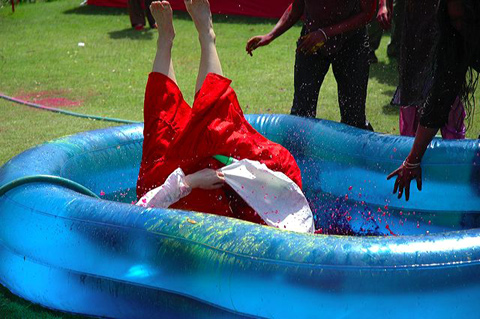
The Center for Knowledge Societies and PikseliÄHKY present
DOORS NIGHT HELSINKI
Thursday, October 6th 2005
Kulttuuritehdas Korjaamo
Töölönkatu 51 B, 00250 Helsinki
Program:
7.30 pm
Presentations by
Aditya Dev Sood of CKS
and
Juha Huuskonen of PikseliÄHKY
followed by comments, questions and discussions by a special panel of
experts and by the audience. The chairman of the panel is Elukka
Eskelinen, director of Media Centre Lume.
9.00 pm until midnight
* Doors 2005 Delhi revisited: Bollywood Nightmares DJ set from
mukul (ambientTV.NET) back-to-back with live mix from Richard
Widerberg, featuring visuals from VJing in Delhi workshop.
* Video artworks from Simon Faithfull (UK), Rob Kennedy (UK)
and Jana Eske (GER).
+ drinks, dancing and discussion among the gathered community!
—
DOORS NIGHTS are a way for people who are interested in the Doors of Perception design conferences to connect in their own town. DOORS NIGHTS are also being planned for Tokyo (January) and Paris (April). If you think another city is ready to host one tell us about it online.
www.doorsofperception.com
You could try blogging your images of the evening through the Doors of Perception group on Flickr. Try using the tag ‘doorsnighthelsinki’ and grouping your images at www.flickr.com/groups/97089260@N00
The Center for Knowledge Societies (CKS) is a research and design practice based in Bangalore and New Delhi. CKS is the author of Used in India, a multidisciplinary documentation project that captures the innovative ways in which Indians have used media and technology in the 20th century. It has produced recent editions of the acclaimed Doors of Perception design conference. Last year, CKS founded the Learning Lab Initiative to promote the creative use of mobile devices for public education in emerging economy environments. www.cks.in
PikseliÄHKY is a festival for electronic art and subcultures. PikseliÄHKY presents projects experimenting with media and technology from a broad range of disciplines: artists, engineers, designers, researchers and architects. PikseliÄHKY focuses especially in presenting activities of various international grassroot networks and communities such as VJ community, media activists, open source community and demoscene. The goal of PikseliÄHKY Festival is to act as a bridge between the traditional creative disciplines and rapidly developing electronic subcultures. www.pixelache.ac
- - -
Simon Faithfull: “Escape Vehicle no.6″(2004, 10min) records the journey of a domestic chair as it travels from the ground to the edge of space (30km up). Dangling in space beneath an unseen weather balloon, the footage shows the chair first rush away from the fields and roads, ascend through clouds and finally (against the curvature of the earth and the blackness of space) begin to disintegrate. The chair’s journey was recorded using a small video camera that relayed the images live to an audience below. The chilling nature of the film is that the empty chair invites the audience to imagine taking a journey to an uninhabitable realm where it is impossible to breath, the temperature is minus 60 below and the sky now resembles the blackness of space.
Simon Faithfull participates in the Helsinki Photography Festival in the autumn 2005. Further info:www.helsinkiphotographyfestival.net, www.simonfaithfull.org
- - -
Rob Kennedy & Cathode : “Sundowning” (5 min) and Rob Kennedy : “EDEN” (2 min)
Rob Kennedy is an artist based in Glasgow, UK, whose work shifts between sculpture, video and live video manipulation. Recent exhibitions/ screenings include: KEN, Glasgow 2004; Wider than the Sky, London 2004; Art Now, Tate Britain, London 2004; Transmediale Festival, Berlin 2004; Sundowning, music video collaboration with Cathode, Machinista Festival, Glasgow 2004; Electric Earth, British Council International Touring Exhibition, 2003-04; Zenomap, Venice Biennale 2003 and The Listener is the Operator, CD-rom and text work in collaboration with Callum Stirling, commissioned by CCA Glasgow for Glasgow Art Fair 2002.
- - -
Jana Eske ‘Concrete’ (3 min), a preview to a media installation
About the artist: A scenographer in training at the ZKM Centre for Art and Media in Karlsruhe, Jana Eske has exhibited her video art works at the Videonale in Bonn. Currently her work can be seen at the Design Museo in Helsinki.
Monday, September 26th, 2005
We would like to thank all the people who have sent us material for the PixelACHE // Mal au Pixel 2006 Call for Projects! We are right now going through the proposals, we will inform you about our decisions in approximately one months time (late October)… Patience…
Meanwhile, if you are in Helsinki - don’t forget the Casey Reas + Marius Watz lecture tomorrow on Tuesday!
Wednesday, September 21st, 2005
(Salón Internacional del Autor Audiovisual reporte en español)
The PixelACHE tentacles are slowly spreading around the globe… The latest addition to the happy PixelACHE Family is Colombia, where I recently had the pleasure to visit the Salón Internacional del Autor Audiovisual film festival in Barranquilla. Together with Vanessa Gocksch we compiled a screening of VJ projects + gave a 3 day VJ workshop + worked together with indigenous Arhuaco and Kogi tribes… Check out the full report + watch out for more PixelACHE activities in Latin America in near future!
Wednesday, September 14th, 2005
PixelACHE Festival & katastro.fi & Generator.x & Media Centre Lume
are happy to present two lectures about generative art and design by
CASEY REAS & MARIUS WATZ
Media Centre Lume, Helsinki
Tuesday 27 September @ 6-8 pm
Free entrance!
- -
MARIUS WATZ
» www.unlekker.net
» www.evolutionzone.com
The work of Marius Watz is concerned with the algorithmic generation of form, whether still, animated or interactive. His work has appeared in international festivals and exhibitions, most recently in Sonar (Barcelona), Virtual Frame (Wien) and Manyfacture (Reykjavik). Marius has also done work for commercial clients such as Nike, Nokia and the mobile company “3”. Marius currently lives in Berlin, where he works and teaches Computational Design at Universität der Künste.
Marius is the director of Generator.x, a project exploring the role of software and generative strategies in current digital art and design. Generator.x brings together some of the most interesting creators in this field to Oslo for a conference / exhibition which opens on 23rd of September.
“True literacy means being able to both read and write. If to use pre-existing software is to “read” digital media, then programming is the equivalent to writing. The Generator.x project focuses on artists and designers who embrace this new literacy not as a technical obstacle, but as a way to redefine the tools and the media they work in.”
Marius Watz will present his own work as well as an overview of the Generator.x event.
- -
CASEY REAS
» www.reas.com
» www.processing.org
Casey Reas is an internationally acclaimed artist, known for his software generated artwork which can be described as ‘organic’ or even ‘beautiful’. Casey studied at the Aesthetics and Computation department of MIT media lab, was one of the founding professors of Interaction Institute IVREA and is currently working as an assistant professor in the department of Design | Media Arts at UCLA.
Casey is the co-author of Processing programming environment which has been designed to teach fundamentals of computer programming within a visual context and to serve as a software sketchbook. Processing software is used by students, artists, designers, architects, researchers, and hobbyists for learning, prototyping, and professional production. Processing software developers were granted the Ars Electronica Golden Nica award in September 2005.
Casey Reas is one of the artists featured in the Generator.x exhibition / conference.
- - -
The lectures of Casey Reas and Marius Watz in Helsinki are organised by PixelACHE festival and katastro.fi in collaboration with Generator.x and Media Centre Lume. Thanks for support: NIFCA - Nordic Institute for Contemporary Art.
www.pixelache.ac - www.katastro.fi - www.generatorx.no - www.lume.fi - www.nifca.org
- - -
Venue for lectures:
Media Centre Lume
University of Art and Design Helsinki, UIAH
Hämeentie 135 C, Helsinki
Public transport to Lume: busses 73 B, 74, 74N, P10, 52, 68, 71, 71V, 509, 732K, tram 6
Friday, July 22nd, 2005
Preliminary information about PixelACHE // Mal au Pixel 2006 is now available! Looking forward to meeting many of you in Helsinki or Paris next spring!
We’ve also done a major update for the PixelACHE website. The information about the PixelACHE 2005 projects is now easier to browse through, in addition you can also find several new event reports and videos… Some recent additions are:
- PIXELACHE05splitInto60evenUnitsof Time video by Vanessa Gocksch
- PixelACHE report from Piksel04
- Report from Visual Sensations VJ competition
More news coming soon, stay tuned!
PixelACHE 2005 Helsinki took place at Kiasma Museum of Contemporary Art, 14-17 April 2005. Read more »
Download and print the PixelACHE 2005 Helsinki publication/catalog
» Screen quality (2 MB)
» Print quality (6 MB)
» Schedule only (0.2 MB)
You are currently browsing the PixelACHE 2005 weblog archives.